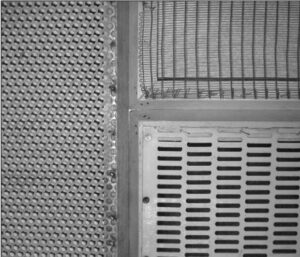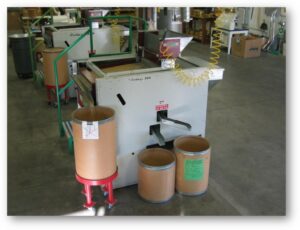Description
The air-screen separator or fanning mill is widely used for cleaning or pre-cleaning seed of many species. It is the basic and perhaps the most used seed cleaning machine. It uses a combination of air, gravity, and screens to separate seed based on size, shape, and density. These widely-use units come in a variety of sizes and models with two to eight vibrating screens. In all cases, the cleaning principles are the same. The seed mass drops onto the top or scalping screen, which catches and removes large trash and impurities. Seed and smaller trash pass through to the next (grading) screen which retains the seed and allows the trash to pass through. Multiple screens provide additional seed size and density separation. Air streams remove the trash and impurities, and the seed is moved to bagging or collection units. Screens are perforated metal with round, oblong, or triangular holes of various sizes or woven wire mesh, similar to window screens, with square or rectangular openings for very small seeds. Hammer like tappers release material caught in the perforations while brushes attached below the screens removing material clinging to them. The rate of feed, airflow, oscillation of the screens, and screen pitch are adjustable. With experience, an operator can set all the variables and achieve excellent results for a wide array of species.
An air-screen separator in operation at the USFS Ashe Nursery Seed Extractory in Mississippi.
Application
Air-screen separators an essential machine in all seed extractories. They are widely used for initial cleaning and upgrading seeds of a wide variety of species once they are dried, de-winged, and extracted. Air-screen separators vary from office-scale machines to industrial-sized devices. Effective use of these machines requires the availability of a good supply of screens with different hole types and sizes to enable cleaning different species and seedlots. Additional equipment may be required to remove problematic debris or seeds of similar size and shape as the target species.
References / Additional Information
Copeland, L.O.; McDonald, M.B. 1985. Principles of seed science and technology. Second edition. Minneapolis, MN: Burgess Publishing Company. 481 p.
Desai, B.B.; Kotecha, P.M.; Salunkhe, D.K. 1997. Seeds handbook: Biology, production, processing, and storage. New York, NY: Marcel Dekker, Inc. 640 p.
Harmond, J.E.; Brandenberg, N.R.; Klein, L.M. 1968. Mechanical seed cleaning and handling. USDA Agricultural Handbook No. 354. Washington, DC: U.S. Department of Agriculture, Forest Service. 56 p.
Harmond, J.E.; Klein, L.M.; Brandenburg, N.R. 1961. Seed cleaning and handling. USDA Agricultural Handbook No. 179. Washington, DC: U.S. Department of Agriculture, Agriculture Research Service. 38 p.
Jorgensen, K.R.; Stevens, R. 2004. Chapter 24. Seed collection, cleaning, and storage. In: Monsen, S.B.; Stevens, R.; Shaw, N.L., comps. Restoring western ranges and wildlands, vol. 3. Gen. Tech. Rep. RMRS-GTR-136-vol-3. Fort Collins, CO: U.S. Department of Agriculture, Forest Service, Rocky Mountain Research Station: 699-716.
Karrfalt, R.P. 2008. Seed harvesting and conditioning. In: Bonner, F.T.; Karrfalt, R.P., eds. The woody plant seed manual. Agric. Handbook No. 727. Washington, DC. U.S. Department of Agriculture, Forest Service. 1223 p.
Vaughan, C.E.; Gregg, B.R.; Delouche, J.C. 1968. Seed processing and handling. State College, MI: Mississippi State University, Seed Technology Laboratory. 149 p.
Young, J.A.; Young, C.G. 1986. Collecting, processing, and germinating seeds of wildland plants. 3rd ed. Portland, OR: Timber Press. 236 p.




